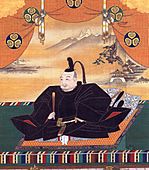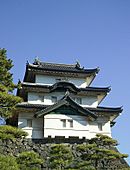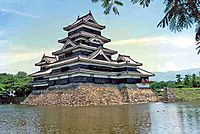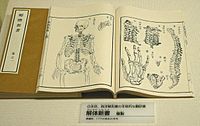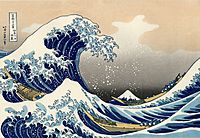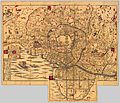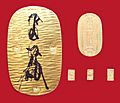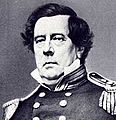Edo period facts for kids
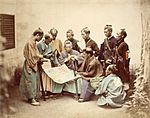 |
|---|
|
Edo period (江戸時代, Edo-jidai), also called the Tokugawa period (徳川時代 Tokugawa-jidai), is the time between 1600 and 1868 in the history of Japan. During this long time Japanese society was ruled by the Tokugawa shogunate and the country's 300 regional feudal lords.
These years come after the Azuchi-Momoyama period and before the Meiji Restoration and the development of modern Japan.
The Tokugawa shogunate was established at Edo in 1603 by the shogun Tokugawa Ieyasu. The period was marked by the influence of neo-Confucianism and Shinto. The 15th and last shogun was Tokugawa Yoshinobu.
The period ended with the Meiji Restoration, which was the restoration of imperial rule. The Edo period is also known as the beginning of the early modern period of Japan.
Timeline
In 1600, the Battle of Sekigahara establishes a context for the next two centuries. Tokugawa Ieyasu defeats a coalition of daimyo and establishes hegemony over most of Japan.
- 1603 ( Keichō 8): The emperor appoints Ieyasu as shogun.
- 1605 ( Keichō 10): Ieyasu resigns as shogun and is succeeded by his son Tokugawa Hidetada.
- 1607 ( Keichō 12): Korean Joseon Dynasty sends an embassy to Tokugawa shogunate.
- 1611 ( Keichō 16): Ryūkyū Islands become a vassal state of Satsuma domain.
- 1613 ( Keichō 16): "Keichō Embassy" (慶長使節) to Americas and Europe.
- 1614 ( Keichō 17): Shogunate bans Christianity from Japan.
- 1615 ( Keichō 18): Battle of Osaka; Ieyasu destroys Osaka Castle and the Toyotomi clan.
- June 1, 1616 (Genna 2, 17th day of the 4th month): Ieyasu died at Suruga Castle.
- 1623 (Genna 9): Tokugawa Iemitsu becomes the third shogun.
- 1633 (Kan'ei 12) Shogunate forbids travelling abroad and reading foreign books.
- 1635 (Kan'ei 12): Shogunate formalizes the system of mandatory alternate residence (sankin kotai) in Edo.
- 1637 (Kan'ei 14): Shimabara Rebellion (1637-38) mounted by overtaxed peasants.
- 1638 (Kan'ei 15): Shogunate forbids ship building.
- 1639 (Kan'ei 16): Edicts establish a policy of National Seclusion (Sakoku).
- 1641 (Kan'ei 18): Shogunate bans all foreigners, except Chinese and Dutch, who may only live in Nagasaki.
- 1650 (Kei'an 3): With peace, there evolved a new kind of noble, literate warrior according to bushido ("way of the warrior").
- 1657 (Meireki 3): T The Great Fire of Meireki destroys most of the city of Edo.
- 1700 (Genroku 13): Kabuki and ukiyo-e become popular.
- December 16, 1707 (Hōei 4, 23nd day of the 11th month): Eruption of Mt. Fuji,
- 1774 (An'ei 3): Kaitai shinsho, the first complete Japanese translation of a Western medical work, is published by Sugita Gempaku and Maeno Ryotaku.
- 1787 (Tenmei 7): Matsudaira Sadanobu becomes the shogunate's senior official (rōjū).
- 1792 (Kansei 4): Russian envoy Adam Laxman arrives at Nemuro in eastern Ezo (now Hokkaidō).
- 1804 (Kyōwa 4): Russian envoy Nikolai Rezanov reaches Nagasaki and unsuccessfully seeks the establishment of trade relations with Japan.
- 1837 (Tenpō 8): Ōshio Heihachirō and Ikuta Yorozu lead uprising was known as Tempo Jiken
- 1841 (Tenpō 12): Tempo Reforms
- 1854 (Kaei 7): Commodore Perry forces the Japanese agreement to the Treaty of Kanagawa. The chief Japanese negotiator was Hayashi Akira.
- 1855 (Ansei 2): Russia and Japan establish diplomatic relations.
- September 5–6, 1864 (Genji 1, 5th-6th day of the 8th month): Bombardment of Shimonoseki by British, French, Dutch and American warships
In 1868, Tokugawa Yoshinobu resigns, the Tokugawa shogunate ends. This marks the end of the Edo period. Emperor Meiji establishes his Imperial capital in Edo, which is renamed Tokyo ("eastern capital").
Picture gallery
-
Tokugawa Ieyasu, first shogun of the Tokugawa shogunate
-
A yagura, or turret, at Edo Castle in Tokyo.
-
Hasekura Tsunenaga, a Samurai and Japan's first official ambassador to the Americas and Europe, 1613-1620.
-
Wadokei, Japanese-made clockwatch, 18th century.
-
Kaitai Shinsho, Japan's first treatise on Western anatomy, published in 1774.
-
The Great Wave off Kanagawa by Katsushika Hokusai (1760–1849).
Economy Trade Diplomacy
In the Edo period, Japan developed very much economically, and accumulation of the capital became the driving force of the economic development after the Meiji Restoration.
Because many daimyos stayed at the inn along the highway by daimyo's alternate-year residence in Tokyo, the circulation of the economy became active.
And due to the stable economy, Japanese special culture such as Nou or Kabuki or Ukiyoe had also developed very well.
The Shogunate instituted a foreign policy of isolationism.
Therefore trade relations carried out by the Shogunate are only Shin (清, Shin) in Nagasaki, and the Netherland in Dejima.
Related pages
- Metropolitan Museum of Art, Art of the Edo Period (1615–1868)
- British Museum, Edo period (AD 1600-1868)
- Japan-guide.com, Edo Period (1603 - 1867)
Images for kids
-
Bird's-eye view of Nagasaki bay, with the island Dejima at mid-left (1833)
-
The San Juan Bautista is represented in Claude Deruet's painting of Hasekura Tsunenaga in Rome in 1617, as a galleon with Hasekura's flag (red manji on orange background) on the top mast.
-
Karakuri puppet Moji-kaki doll made by Tanaka Hisashige. Using mechanical power, a puppet dips a brush into ink and writes a character on paper. 19th century
-
Red and White Plum Blossoms by Ogata Kōrin, 1712-1716
-
Mounting for wakizashi decorated with lacquer of maki-e technique. 18th century
-
The Great Wave off Kanagawa, full-colour ukiyo-e woodblock print, Hokusai, c. 1829–1832
-
Outer kimono for a young woman (uchikake), 1840–1870, Khalili Collection of Kimono
-
One of the cannons of Odaiba, now at the Yasukuni Shrine. 80-pound bronze, bore: 250mm, length: 3830mm
-
Landing of Commodore Perry, Officers and Men of the Squadron To meet the Imperial Commissioners at Kurihama Yokosuka March 8th, 1854
-
Tokugawa Yoshinobu in later life
-
Ukiyo-e depicting Sushi, by Hiroshige
-
Inro and Netsuke, 18th century
See also
 In Spanish: Período Edo para niños
In Spanish: Período Edo para niños


